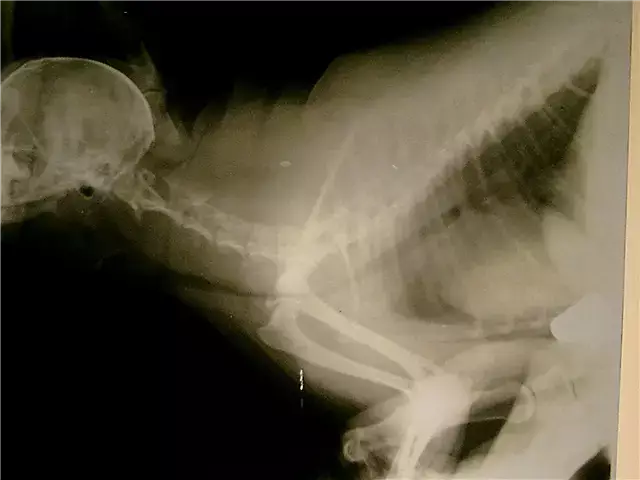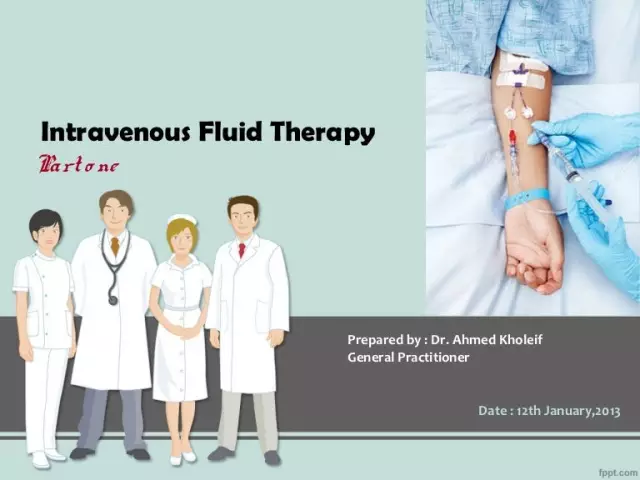- Author Rachel Wainwright [email protected].
- Public 2023-12-15 07:39.
- Last modified 2025-11-02 20:14.
Walcite
Instructions for use:
- 1. Release form and composition
- 2. Indications for use
- 3. Contraindications
- 4. Method of application and dosage
- 5. Side effects
- 6. Special instructions
- 7. Drug interactions
- 8. Analogs
- 9. Terms and conditions of storage
- 10. Terms of dispensing from pharmacies

Valcyte is a drug belonging to the group of antiviral agents.
Release form and composition
It is produced in the form of film-coated tablets (in polyethylene bottles of 60 pieces, 1 bottle in a cardboard box).
The active ingredient is valganciclovir hydrochloride, 450 mg in 1 tablet.
Auxiliary components: microcrystalline cellulose - 47.8 mg; crospovidone - 23.9 mg; povidone K30 - 23.9 mg; stearic acid - 6 mg.
Fillers for the film shell: titanium dioxide (E171), iron oxide red (E172), hydroxypropyl methylcellulose, polysorbate, polyethylene glycol, purified water.
Indications for use
Valcyte is prescribed for the treatment of cytomegalovirus retinitis in patients with AIDS, as well as for the prevention of cytomegalovirus infection after organ transplantation.
Contraindications
- The platelet count is less than 25,000 cells / μl;
- Creatinine clearance less than 10 ml / min;
- The absolute number of neutrophils is less than 500 cells / μl;
- Hemoglobin concentration below 80 g / l;
- Hypersensitivity of the patient to ganciclovir, valganciclovir, as well as to any of the components of the drug (cross-sensitivity reactions to Valcyte, valacyclovir and acyclovir are possible, which is explained by the similar chemical structure of these drugs);
- Pregnancy and lactation period;
- Age less than 12 years old.
The drug is prescribed with caution to patients with renal insufficiency, as well as to the elderly (efficacy and safety for this age category have not been established).
Method of administration and dosage
The drug is recommended to be taken orally with meals.
To avoid overdose, you should strictly adhere to the dosage regimen recommended by the instruction:
- Induction therapy for patients with active cytomegalovirus retinitis - take 900 mg 2 times a day for 3 weeks. With prolonged induction therapy, the risk of myelotoxicity increases;
- Supportive therapy after induction therapy in patients with inactive cytomegalovirus retinitis - 900 mg once a day. If the course of retinitis worsens, it is allowed to repeat the course of induction therapy;
- Prevention of cytomegalovirus infection after organ transplantation - take from 10 to 100 days after transplantation, 1 time per day, 900 mg.
During the treatment of patients with renal failure, serum creatinine levels or creatinine clearance (CC) should be carefully monitored. For men, creatinine clearance is calculated depending on its serum level using the following formula: (140 - age (years)) × body weight (kg)) / 72 × 0.011 × serum creatinine, μmol / L. For women, CC = 0.85 × indicator for men. The following is the calculation for men:
- With CC 10-24 ml / min, the dose for induction therapy is 450 mg every 2 days, for maintenance therapy - 450 mg 2 times a week;
- With CC 25-39 ml / min, the dose for induction therapy is 450 mg 1 time per day, for maintenance therapy - 450 mg every 2 days;
- With CC 40-59 ml / min, the dose for induction therapy is 450 mg 2 times a day, for maintenance therapy - 450 mg 1 time a day;
- With CC from 60 ml / min, the dose for induction therapy is 900 mg 2 times a day, for maintenance therapy - 900 mg 1 time per day.
You should not prescribe Valcyte to patients on hemodialysis (CC less than 10 ml / min).
In case of neutropenia, thrombocytopenia, bone marrow suppression, severe leukopenia, anemia, pancytopenia, aplastic anemia, it is not recommended to start therapy if the platelet concentration is less than 25,000 cells / μL or the neutrophil content is less than 500 cells / μL, as well as if the hemoglobin level is below 80 g / l.
Side effects
Clinical trial data:
In patients after organ transplantation, the most common side effects that occur while taking Valcyte are: tremors, swelling of the lower extremities, back pain, headaches, insomnia, transplant rejection, nausea, vomiting, diarrhea, and hypertension. Most of the listed manifestations are moderately or weakly expressed.
Among the most common adverse reactions when taking the drug by patients with AIDS and cytomegalovirus retinitis are: neutropenia, fever, weakness and headaches, oral candidiasis, diarrhea.
Among patients after transplantation with a frequency of ≥2%, adverse events were noted that were not observed among patients with cytomegalovirus retinitis: liver dysfunction, hypertension, hyperkalemia, hypercreatinininemia.
Side effects reported in more than 5% of patients after organ transplantation and with cytomegalovirus retinitis:
- On the part of the body as a whole: weakness, peripheral edema, edema of the lower extremities, fever, anorexia, decreased appetite, dehydration, cachexia, weight loss, graft rejection;
- Infectious complications: oral candidiasis, pharyngitis, nasopharyngitis, upper respiratory tract infection, sinusitis, pneumonia, urinary tract infections;
- Dermatological reactions: increased sweating (at night), acne, dermatitis, itching;
- From the side of the organ of vision: blurred vision, retinal detachment;
- From the urinary system: dysuria, renal failure, urinary tract infections;
- From the digestive system: nausea and vomiting, constipation, dyspepsia, diarrhea, ascites, abdominal pain, liver dysfunction;
- From the hematopoietic system: anemia, leukopenia, neutropenia, thrombocytopenia;
- From the central and peripheral nervous system: insomnia, tremor, paresthesia, headaches and dizziness, peripheral neuropathy, depression;
- From the respiratory system: productive cough, pleural effusion, nasopharyngitis, pharyngitis, nasal discharge, sinusitis, pneumonia, pneumocystis pneumonia, upper respiratory tract infections, shortness of breath;
- From the musculoskeletal system: arthralgia, muscle cramps, back pain, pain in the limbs;
- From the side of the cardiovascular system: arterial hypotension, arterial hypertension;
- Laboratory indicators: hyperkalemia, hypokalemia, hyperglycemia, hypocalcemia, hypercreatinininemia, hypomagnesemia, hypophosphatemia;
- Others: in the postoperative period, complications, increased wound drainage, poor wound healing, infectious complications of a postoperative wound, pain after surgery may occur.
Serious side effects caused by taking Valcyte, occurring with a frequency of less than 5%:
- From the urinary system: hypercreatinininemia, decreased creatinine clearance;
- From the side of the central and peripheral nervous system: mental disorders, confusion, hallucinations, agitation, convulsions;
- From the side of the hematopoietic system: inhibition of bone marrow function, pancytopenia, aplastic anemia;
- From the side of the blood coagulation system: life-threatening bleeding;
- Others: hypersensitivity to valganciclovir.
Valcyte is rapidly synthesized into ganciclovir, therefore, side effects typical of ganciclovir may occur during therapy.
special instructions
The drug is not recommended for prescribing to children, since its effectiveness, safety and pharmacological characteristics have not been established for this age category.
In the course of therapy, it is necessary to regularly monitor the expanded blood count with platelets. Patients suffering from neutropenia, thrombocytopenia, leukopenia, anemia are prescribed growth factors and / or the drug is discontinued.
Ganciclovir cannot be substituted for Valcyte in a 1: 1 ratio, since the bioavailability of ganciclovir from Valcyte is 10 times higher than that of ganciclovir capsules. Patients transferred from ganciclovir capsules should be informed about the risk of overdose if they take Valcin in doses exceeding those recommended.
Experimental studies on animals have shown the teratogenic, carcinogenic, mutagenic, spermatocidal effect of ganciclovir. Valcyte is considered a potential carcinogen and teratogen in humans, the use of which is associated with the risk of cancer and congenital malformations. There is a possibility that the drug can permanently or temporarily suppress spermatogenesis.
The ability to drive a car and use mechanisms can be impaired if the patient develops such adverse reactions as sedation, confusion, ataxia or dizziness.
Breaking or crushing of the tablet is not allowed, since Valcyte is a potential carcinogen and teratogen for humans. Do not allow direct contact of the tablet, the integrity of which has been violated, with mucous membranes and skin. If such contact occurs, the skin should be washed immediately with soap and water (the eyes should be thoroughly washed with water).
Drug interactions
Since Valcyte is synthesized into ganciclovir, interactions specific to ganciclovir may be expected with Valcyte.
Concomitant use of ganciclovir and cilastatin / imipenem should be allowed only if the benefits of such therapy outweigh the potential risk - the combined use of these drugs can cause seizures.
AUC of zidovudine may slightly, but statistically significantly increase (up to 17%) with simultaneous oral administration of ganciclovir. There may also be a tendency (statistically insignificant) to decrease the concentration of ganciclovir. Some patients cannot tolerate full doses of both drugs at the same time, because ganciclovir and zidovudine can cause anemia and neutropenia.
Concomitant administration of mycophenolate mofetil and ganciclovir may increase the content of ganciclovir and mycophenolic acid phenolic glucuronide.
In patients undergoing cyclosporine therapy, after the start of ganciclovir use, a slight increase in the maximum serum creatinine level was detected.
When taking Valcyte and probenecid at the same time, it is recommended that patients be examined for ganciclovir toxicity.
The concentration of didanosine with simultaneous use with ganciclovir steadily increases, so patients with such therapy should be monitored for signs of toxic effects of didanosine.
Concomitant therapy of ganciclovir with other drugs that impair renal function or have a myelosuppressive effect can increase their toxic effects, so such treatment can be prescribed only in cases where the potential benefit outweighs the potential risk.
Analogs
Valcite analogues are: Tsivalgan, Valganciclovir.
Terms and conditions of storage
Store at a temperature not exceeding 30 ° C out of reach of children.
The shelf life is 3 years.
Terms of dispensing from pharmacies
Dispensed by prescription.
Information about the drug is generalized, provided for informational purposes only and does not replace the official instructions. Self-medication is hazardous to health!






